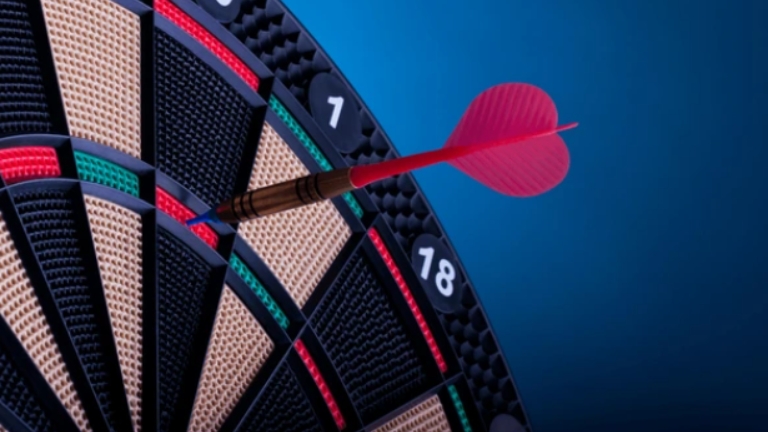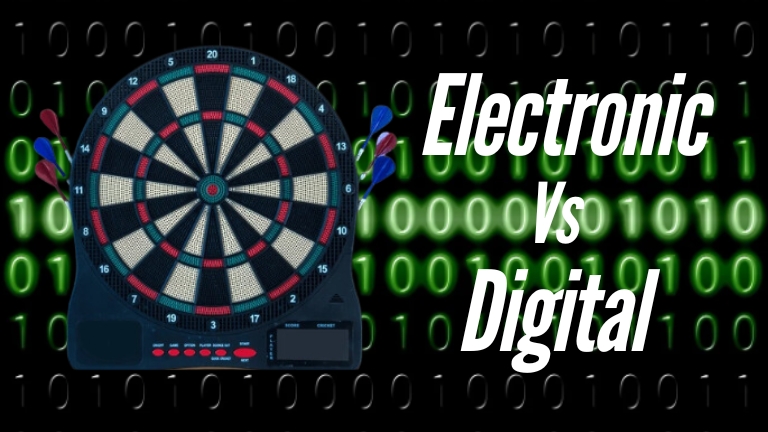As you step into the world of modern darts, you may notice terms such as “electronic dartboard” and “digital dartboard” used synonymously. This could raise questions: why do these terms often mean the same thing? What makes an electronic dartboard “digital,” and is there any real difference between these descriptions?
But, to understand all this properly, we have to know just what these devices are, what their features are, and the technology behind them. So let’s get started!
Understanding the Terminology: Electronic vs. Digital
Before we explore why an electronic dartboard is also called a digital dartboard, it’s essential to understand the difference between “electronic” and “digital.” While in most instances these terms have been used interchangeably, they really do have somewhat different meanings, depending on the context in which they are used.
From a semantic point of view, “electronic” and “digital” are not exactly synonymous, but they do share considerable overlap in meaning when applied to dartboards. “Electronic” refers to electrical components, circuits, and systems. In effect, all digital systems are electronic, but not all electronic systems are digital.
The word “digital” in the context of dartboards points out the computational and interactive features, such as automatic scoring, pre-programmed games, and application integration. Digital refers to systems that process information in binary format, using discrete data points (1 and 0). On the other hand, “electronic” is a broad term; it means all those hardware components and mechanisms that work to make those features run.
In the case of a dartboard, the two terms somewhat interlink. The “electronic” nature refers to the usage of electricity and electronic parts in its operation, whereas “digital” refers to digital technology for data processing and displaying scores.
Thus, an electronic dartboard is usually referred to as a digital dartboard because it uses digital technology for scoring and game management.
Functional Similarities: Why the Terminology Gets Mixed Up
Electronic dartboards were called “digital” because they had features that are similar to digital technology. Here’s why this happens:
Digital Displays: Most electronic dartboards have LED or LCD screens that display scores, player stats, and game modes. The presence of these displays, which rely on digital technology, makes “digital dartboard” a fitting description.
Additional Customizable Options: Modern digital dartboards come with different game modes, settings, and advanced scoring. These features show that they have the same qualities as other ‘digital’ devices, like being interactive and able to be programmed.

Connectivity: Advanced models are linked to smartphones, tablets, or other devices using either Bluetooth or Wi-Fi connectivity options. This ability places them within the greater context of today’s digital devices, nearly universally touting their levels of connectivity and integration.
Automation: The automation of calculating scores and tracking the game further cements the “digital” identity through the precision of algorithms and digital management of data.
Consumer Views and Selling
Using “electronic” and “digital” can be about more than just how something works; it’s also about how people see it and how it’s sold. The word “digital” feels modern, new, and smart to customers. Sellers often pick this word to show that a product is advanced, even if “electronic” is more correct in a technical way.
For example:
- Calling a dartboard “digital” shows off its smart scoring and connection features.
- “Electronic” might seem like a general or older word, not making the product sound as high-tech.
Historical Background: The Shift to Electronic Dartboards
The transition from traditional to electronic dartboards began in the late 20th century. Early electronic dartboards were relatively simple, focusing on basic scorekeeping. Over time, technological advancements introduced features like:
- Voice instructions and score announcements.
- Different game options for players of all skill levels.
- Online multiplayer games, allowing people to play worldwide.
These improvements expanded what an electronic dartboard could offer, leading many people and companies to call it a “digital” dartboard.
The Role of Language in Technology
Language evolves alongside technology, often adopting new terms to reflect innovations. The adoption of “digital dartboard” for electronic models is an example of this linguistic shift. This phenomenon isn’t unique to dartboards; it occurs across various industries:
Televisions: Early TVs were described as “electronic,” while modern iterations are called “digital” or “smart TVs” due to features like streaming and connectivity.
Watches: Traditional timepieces were “analog,” succeeded by “digital watches,” and now “smartwatches.”
In each case, the terminology reflects the device’s technological evolution and added functionalities. Similarly, calling an electronic dartboard “digital” highlights its advanced, interactive features.

The Technical View
From a technical standpoint, calling an electronic dartboard “digital” is accurate if the device incorporates:
Microprocessors: These are important parts of digital devices. They handle information and allow features such as automatic scoring and changing game rules.
Digital Sensors: Many electronic dartboards use these sensors to accurately detect where the darts land.
Data Representation: Using numbers or binary code to calculate scores and show the results is a key part of digital technology.
Why the Difference is Important
Understanding the difference between “electronic” and “digital” is important for a few reasons:
Better Choices: Knowing the difference helps people choose the right dartboard for their needs.
Clearer Marketing: Companies can highlight their digital features to attract tech-loving customers.
Reflecting Trends: The words used show how technology is changing society, even in fun things like dartboards.
FAQs
How does digital darts work?
Digital darts uses an electronic dartboard embedded with sensors to detect dart hits. Players throw soft-tipped darts, which land in target areas made of plastic with small holes.
The board’s sensors automatically record scores based on the dart’s position, displaying results on an integrated screen or a connected app. Advanced boards include online play features, allowing players to compete globally. This eliminates manual scoring, enhancing accuracy and simplifying gameplay.
What is a smart dartboard?
A smart dartboard is an advanced dartboard equipped with technology to enhance gameplay, track scores, and provide interactive features. Unlike traditional boards, smart dartboards connect to mobile apps or devices via Bluetooth or Wi-Fi, allowing players to view real-time scoring, track performance, and participate in online games with others worldwide.
Many smart boards feature built-in sensors or cameras to accurately register dart hits, eliminating the need for manual scorekeeping. These dartboards often come with additional game modes, tutorials, and training features to help players improve their skills.
Conclusion
Understanding this terminology isn’t just about semantics; it’s about appreciating how technology has transformed a classic game. Whether you call it an electronic dartboard or a digital dartboard, one thing is clear: these modern marvels have brought new dimensions to the game of darts, making it more engaging, accessible, and fun for players of all levels.

